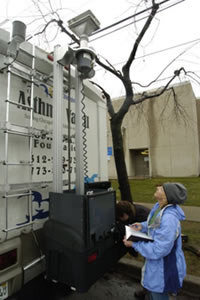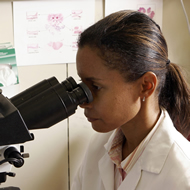
Environmental Factor, November 2008, National Institute of Environmental Health Sciences
Superfund Study Detects PCB11 in Ambient Air
By Melissa Fabiano
November 2008


A new year-long study conducted by researchers at the University of Iowa (UI) Superfund Basic Research Program (SBRP) reports finding unexpectedly high levels of polychlorinated biphenyls (PCBs), particularly PCB11 (3,3´-dichlorobiphenyl), pervasive in Chicago´s urban air. Keri Hornbuckle, Ph.D., professor of Civil and Environmental Engineering at UI and research engineer for IIHR-Hydroscience and Engineering, led the study with funding (http://tools.niehs.nih.gov/portfolio/sc/detail.cfm?appl_id=7406731)![]() provided by NIEHS.
provided by NIEHS.
PCB production ceased in the 1970s due to the high toxicity of most PCB congeners and mixtures. PCBs are classified as persistent organic pollutants which bioaccumulate in animals.
“It has been assumed that PCBs would eventually be virtually eliminated,” Hornbuckle (http://www.engineering.uiowa.edu/faculty-staff/profile-directory/cee/hornbuckle_k.php)![]() explained, “[but] PCB11 is ubiquitous in air throughout the city of Chicago. We do not know if there are any health concerns associated with this [specific form of the] compound, but there are very few published studies of its toxic properties.”
explained, “[but] PCB11 is ubiquitous in air throughout the city of Chicago. We do not know if there are any health concerns associated with this [specific form of the] compound, but there are very few published studies of its toxic properties.”
The study (http://pubs.acs.org/cgi-bin/abstract.cgi/esthag/asap/abs/es801823r.html)![]() was posted online September 24 and will be published in an upcoming issue of Environmental Science and Technology. To the best of her knowledge, Hornbuckle explained, this “is the first published report on PCB11 in ambient air.”
was posted online September 24 and will be published in an upcoming issue of Environmental Science and Technology. To the best of her knowledge, Hornbuckle explained, this “is the first published report on PCB11 in ambient air.”
The air sampling was carried out in collaboration with Chicago´s Mobile C.A.R.E. Foundation (http://www.mobilecarefoundation.org/)![]() . This non-profit organization, which is dedicated to providing free asthma care and education to children in underserved areas of the city, allowed Hornbuckle´s team to install high volume air sampling equipment on two health clinic vans. The equipment collected air samples at more than 37 sites in Chicago while C.A.R.E. staff provided health services to help diagnose and treat respiratory illnesses of elementary students and families.
. This non-profit organization, which is dedicated to providing free asthma care and education to children in underserved areas of the city, allowed Hornbuckle´s team to install high volume air sampling equipment on two health clinic vans. The equipment collected air samples at more than 37 sites in Chicago while C.A.R.E. staff provided health services to help diagnose and treat respiratory illnesses of elementary students and families.
Air samples were analyzed to determine the presence of any of the 209 PCB congeners or derivatives. Of the 184 samples collected, 91 percent contained PCB11. It is particularly interesting that, in some air samples, PCB11 comprised up to 15 percent of the total PCBs measured, raising concerns that there could be multiple current sources of the compound.
The PCB11 congener was found throughout Chicago´s residential areas. Previous reports of PCB11 in wastewater effluent from pigment manufacturing suggest that the compound is either an historical or current component of consumer paint products. No confirmed source of PCB11 was identified.
PCBs are manufactured chemicals. From the 1920-70s, the Monsanto Chemical Company manufactured and marketed PCB mixtures known as Aroclors. PCB11 is not a dominant component of Aroclor, but may be a byproduct of the degradation of paint, resins and pigments, such as diarylide yellow. In addition to PCB11 being widely distributed in Chicago´s air, the congener has also been detected in the wastewater effluent and sediment samples collected downstream from industrial runoff.
PCB11 is one of the more volatile PCBs and, as a result, inhalation may be an important route for human exposure. For example, as Hornbuckle explained, if PCB11 is “present in interior paints, then indoor concentrations may be much higher” than reported in outdoor air. Hornbuckle concluded that further study is necessary because there is a possibility that “PCB11 is present not only in Chicago, but in air elsewhere and also in fish, soil, water, food and humans.”
Citation: Hu D, Martinez A, Hornbuckle KC. (http://pubs.acs.org/cgi-bin/abstract.cgi/esthag/asap/abs/es801823r.html) ![]() 2008. Discovery of Non-Aroclor PCB (3,3'-Dichlorobiphenyl) in Chicago Air. Environ. Sci. Technol [Epub ahead of print] 10.1021/es801823r.
2008. Discovery of Non-Aroclor PCB (3,3'-Dichlorobiphenyl) in Chicago Air. Environ. Sci. Technol [Epub ahead of print] 10.1021/es801823r.
(Melissa Fabiano is a communications specialist for MDB, Inc., a contractor for the SBRP and the Worker Education and Training Program. She is a regular contributor to the Environmental Factor.)
"Healing Process Found......" - previous story ![]()
![]() next story - "Extramural Update......"
next story - "Extramural Update......"
November 2008 Cover Page



